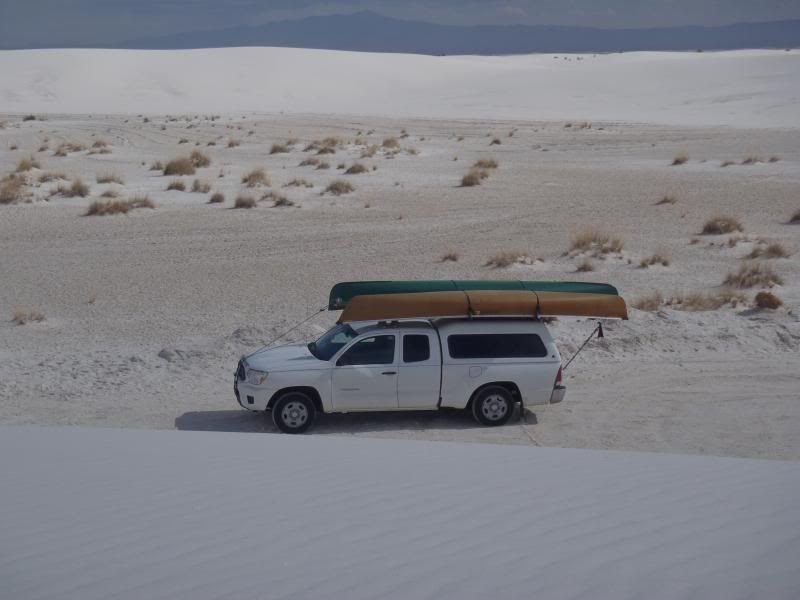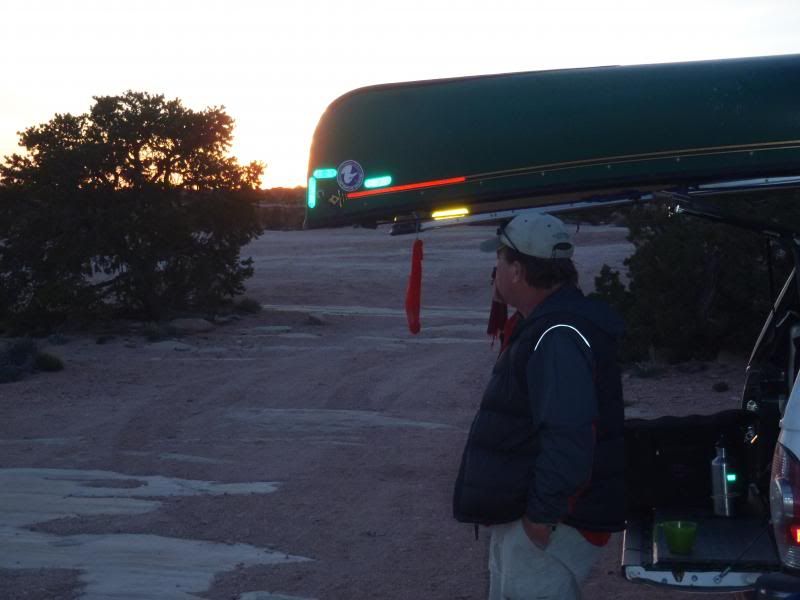I had some real frankenstein racks on my old Grand Caravan that gave me something like 10' of bar spread. As a result I had 4 cross braces.
We had the last model year the Plymouth Voyager sported rain gutters. Great boat toter with multiple crossbars. Horrible Chrysler transmission(s).
Same as on our E-150. Four sets of Quick and Easy crossbars spaced out along 11 feet of roofline. That will accommodate 4 canoes, all resting gunwales flat, staggered one forward, one back, one forward, one back.
Hull 1 and 3 load from the front, with the gunwales resting on crossbars 1 and 3, canoes 2 and 4 load from the back and rest on crossbars 2 and 4. Nice load spacing, so no crossbar is holding more than two canoes.
Fitting the gunwale stops was tricky, since I wanted to be able to
slide the canoes onto the very high racks from either end. I put wood block gunwale stops on the middle bars to trap one stem between the outwales. Once the bow slides into that /____\ trap I know the boat is properly positioned on the racks.
I didn’t want wood blocks spaced out along the length of the front and rear crossbars occluding my slide on loading action, so I paired the wood gunwale blocks to trap just the outboard edge of the gunwales. Hard to describe, picture wood gunwale blocks set just a gunwale width apart on each crossbar edge \\--------------//. Once I slide the bow into that V trap I just lift the stern and set it between the outboard gunwale stops.

Having a center brace (or two) does help to cinch down a load securely but mostly it's just a pain in the arse because every boat you haul will need to be handled differently. The more rise there is to the shear the higher the gunwales will be above the center rails.
With any of our canoe choice configurations I just tie off the belly lines to the respective gunwale contact crossbars. I sometimes throw a mid-roof belly line over all four, but it really isn’t doing much, since none of the gunwale actually contact the midships crossbars.
And if you ever try to carry a kayak right side up, especially if it has any rocker, it will want to contact the center bar(s) first. All this leaves you carrying around multiple thicknesses of foam trying to find the right combination to take up the empty space but not put undue stress on the hull.
Of course if you're only carrying canoes upside down then you can just let the gunwales float over that center bar without strapping them down to it unless you think you need the extra security; then you can start playing the 'fit the foam' game. I didn't have that option since my far forward and rear cross bars weren't strong enough to support the canoe by themselves, rather they just kept the bow/stern from being blown to the side. So for anything more than a quick one mile drive to the local river it was a bit of an ordeal.
The four boat van rack is a bit of a loading ordeal.
There are eye bolts through those wood gunwale blocks so that the belly lines wrap tight to the hull edges. Lots of eye bolts. 16 (I just counted). That does require a very specific canoe loading and belly line tie off order. I can’t get to the middle eye bolts after the outboard positioned canoes are in place, so there is a here is round and round the van alternating side pattern for running the belly lines.
16 eye bolts, four different belly lines. I started carrying two step ladders, so I didn’t have to remember to carry one from alternating side to side as I danced around the van.
It is also a little specific as to which family canoes choices best fit in which slot without rubbing against each other. I have a stack of index card sketches to remind me which canoes best fit where.
I do have a couple sets of custom carved minicel cradles to hold the far ends for a couple of the decked boat better against a third crossbar, attached via a couple of webbing straps with the cradle position sharpie marked on the bar.



